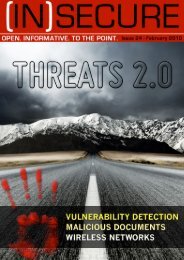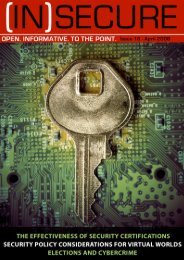download issue 27 here - Help Net Security
download issue 27 here - Help Net Security
download issue 27 here - Help Net Security
Create successful ePaper yourself
Turn your PDF publications into a flip-book with our unique Google optimized e-Paper software.
The five key tenets to PCI–compliant virtualized<br />
environments are:<br />
1. Isolate/segment workloads or servers or<br />
virtual machines.<br />
2. Isolate/segment networks or groups of<br />
servers or groups of virtual machines.<br />
3. Protect server or virtual machine contents.<br />
4. Log and audit all events including administrator<br />
activity.<br />
5. Continuously monitor security against<br />
changes.<br />
The following briefly describe each tenet and<br />
offer guidance on how they can be accomplished<br />
in the virtualized environment:<br />
Tenet 1: Isolate/segment workloads or<br />
servers or virtual machines<br />
Protecting cardholder data implies that if a<br />
server containing the data is compromised,<br />
that the risk is limited to that server alone, and<br />
not others who are logically or physically<br />
connected to it.<br />
In order to ensure this protection, requirement<br />
number one of the PCI DSS is to “install and<br />
maintain a firewall configuration.” In the physical<br />
world, this type of protection is provided by<br />
network firewalls. Rules are defined and enforced<br />
to limit traffic in and out of servers that<br />
contain cardholder data, sent to only known<br />
traffic sources and expected protocols. If for<br />
some reason the server becomes infected<br />
with a virus that attempts to spread itself, the<br />
unauthorized connection attempt will be<br />
blocked.<br />
The same type of protection and isolation is<br />
possible with hypervisor-based firewall technology.<br />
Policies limit access to the virtual machine<br />
by application, protocol and port, ensuring<br />
that only authorized traffic sources can<br />
gain access. The underlying firewall technology<br />
is the same that is used to protect cardholder<br />
data in physical networks, but it has<br />
been optimized for performance and security<br />
in the virtualized environment. Employing a<br />
virtual firewall allows organizations to comply<br />
with PCI DSS requirement 2.2.1 – which calls<br />
for “one function per server” – without requiring<br />
that separate VM hosts be purchased for<br />
each in-scope VM or VM group.<br />
Tenet 2: Isolate/segment networks or<br />
groups of servers or virtual machines<br />
In addition to isolating individual VMs and ensuring<br />
warranted access, the same process<br />
must be applied to groups of virtual machines.<br />
This becomes particularly apt in the cloud<br />
hosting environment w<strong>here</strong> the cardholder<br />
data bearing VMs of customer A must be<br />
segmented from those of customer B. Isolation<br />
of groups between virtual machines can<br />
be accomplished in a number of ways. One<br />
may choose to confine certain VMs to a given<br />
physical host. However, this can get expensive<br />
in larger deployments. Another common<br />
way is through VLAN segmentation w<strong>here</strong> virtual<br />
switch and port assignments are maintained<br />
for certain groups of VMs.<br />
This method is popular but becomes quite<br />
cumbersome to manage at scale w<strong>here</strong> new<br />
VMs are created or introduced frequently. The<br />
challenge with the latter method is that errors<br />
and misconfiguration (i.e. a VM assigned to<br />
the wrong VLAN) are quite common. For best<br />
results, virtualization security experts should<br />
combine VLAN segmentation with virtual firewall<br />
technology. The former can enforce VM<br />
to VLAN assignment automatically so that that<br />
the risk to cardholder data posed by VLAN<br />
mis-assignment is virtually eliminated.<br />
Tenet 3: Protect server or virtual machine<br />
contents<br />
Just as in the physical world, cardholder data<br />
on VMs must be protected from prying eyes<br />
and possible theft. CSOs and security administrators<br />
need to take the necessary measures<br />
to protect the physical media carrying the VMs<br />
as well as securing the data at rest on the<br />
VMs. Encryption, which is put forth explicitly in<br />
PCI DSS requirement number two, is essential<br />
for this purpose as is multi-factor user<br />
authentication. The former should be applied<br />
at all layers, disk and data and to all instances<br />
of the VM, including backups. Also, strong<br />
authentication will ensure that only those administrators<br />
with the highest and appropriate<br />
privilege will be able to access cardholder<br />
data. Most virtualization platforms broadly<br />
support available encryption and authentication<br />
technologies, although verification of<br />
software version compatibility is strongly<br />
advised.<br />
www.insecuremag.com 30





